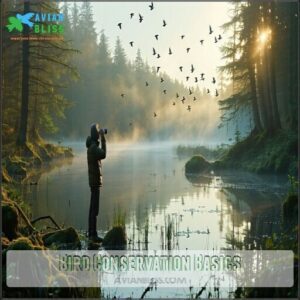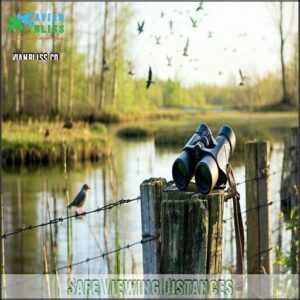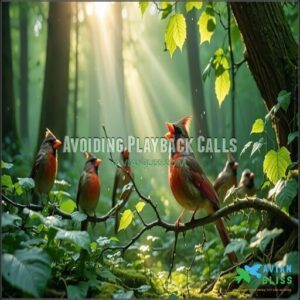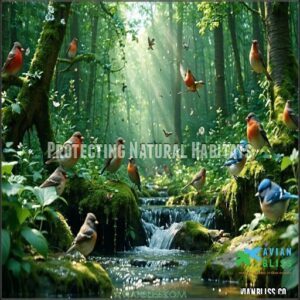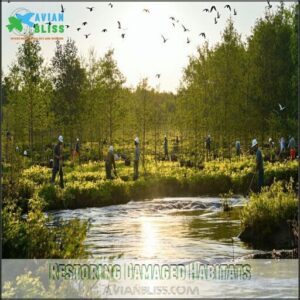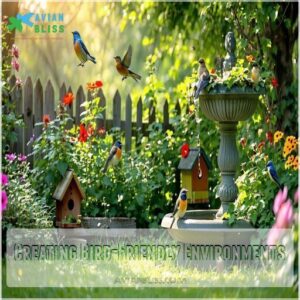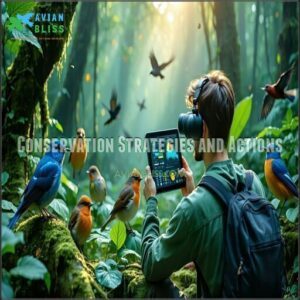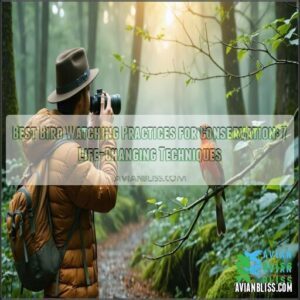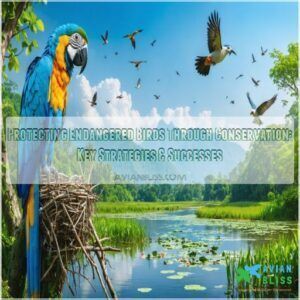This site is supported by our readers. We may earn a commission, at no cost to you, if you purchase through links.

Skip the playback calls; they might seem harmless, but they can disrupt birds’ natural behaviors.
Citizen science projects, like bird counts, are a fun way to help track populations and migration trends.
At home, plant native species to create safe nesting and feeding areas, and consider reducing pesticide use, as even small actions can make a big difference.
Every bird you watch teaches you something—stay curious, and you’ll find there’s so much more to learn about bird habitats!
Table Of Contents
- Key Takeaways
- Bird Conservation Basics
- Observing Birds Responsibly
- Habitat Preservation Methods
- Citizen Science and Research
- Conservation Strategies and Actions
- Frequently Asked Questions (FAQs)
- What is bird conservation?
- How can we promote bird conservation?
- How do birds help the environment?
- What is the future of bird conservation?
- What are the best practices for wildlife observation?
- Why is it important to conserve birds?
- How to help bird conservation?
- What is an action you can do to promote the conservation of a specific bird species?
- Why is bird monitoring important to conservation?
- How can urban gardens support local bird species?
- Conclusion
Key Takeaways
- Watch birds from a distance (at least 100 feet) and use binoculars or cameras to avoid disturbing their natural behaviors.
- Skip using playback calls; they disrupt birds’ behaviors and can stress them unnecessarily.
- Help protect habitats by planting native species, reducing pesticide use, and creating bird-friendly environments at home.
- Participate in citizen science projects to monitor bird populations and migration trends, providing valuable data for conservation efforts.
Bird Conservation Basics
You’ll make a significant impact on bird populations by observing their natural behaviors and participating in conservation efforts from a respectful distance.
Your careful observations provide valuable data that scientists use to track migration patterns, monitor population changes, and develop effective habitat protection strategies.
Importance of Bird Conservation
Birds aren’t just pleasant backyard visitors—they’re ecosystem engineers.
When you protect bird populations, you’re safeguarding indicator species that signal ecosystem health long before other warning signs appear.
Birds provide immeasurable economic value through tourism and pest control while holding deep cultural significance worldwide.
Birds enrich our lives through culture, tourism, pest control, and their vital role in maintaining ecosystem balance.
They’re nature’s frontline workers, supporting human well-being by pollinating plants, dispersing seeds, and maintaining habitat balance.
Your bird conservation efforts directly protect the delicate web that sustains all life, which is a crucial aspect of preserving ecosystem health.
Threats to Bird Populations
While birds are essential for our ecosystems, they face unprecedented challenges today.
Your feathered neighbors are battling against multiple threats that have caused alarming population declines. One of the most significant factors is agricultural expansion, impacting 74% of threatened species.
The three biggest threats include:
- Habitat loss – with over half of Earth’s natural habitats converted for human use
- Climate change – disrupting migration patterns and food availability
- Pesticide contamination – directly poisoning birds and reducing their food sources
Role of Humans in Conservation
You’re more powerful than you think in the fight for bird habitat conservation. Through ethical interactions and sustainable practices, your daily choices directly impact bird populations.
When you collect observation data through citizen science, you provide essential information for conservation policy development. Community involvement in habitat stewardship projects creates lasting change, while raising public awareness inspires others to join the cause.
Your actions truly matter in making a difference, and by participating in these efforts, you contribute to the larger goal of conservation.
Observing Birds Responsibly
You’ll protect essential bird habitats every time you observe them with binoculars from a safe distance, maintaining at least 100 feet to prevent stress and disruption of natural behaviors.
Your responsible observation practices, including staying on designated trails and avoiding disruptive sounds or calls, directly contribute to conservation efforts.
By preserving the environments birds need to thrive, your actions support the well-being of these species, and conservation efforts are enhanced through your consideration and responsible behavior.
Safe Viewing Distances
Now that you understand the conservation basics, maintaining proper distance from birds is your first step to responsible observation.
Respecting safe viewing distances protects both birds and their habitats.
To achieve this, follow these guidelines:
- Keep at least 100 feet away from most bird species
- Use binoculars instead of approaching closer
- Stay twice as far from nesting areas during breeding season
- Position yourself to avoid blocking flight paths
- Practice ethical photography with long lenses
Minimizing Stress on Birds
Three telltale signs of avian stress include freezing, alarm calls, and rapid head movements.
When you notice these behaviors, slowly back away to guarantee bird welfare.
Keeping voices low during birdwatching reduces noise disruption that can interfere with communication and feeding patterns.
Responsible observation means staying motionless when possible and avoiding sudden movements.
Ethical photography requires patience—letting birds acclimate to your presence before capturing their natural behaviors, prioritizing bird wellbeing over perfect shots.
Avoiding Playback Calls
When you spot that elusive warbler, you might be tempted to play its call. But resist that urge! Playback calls disrupt natural bird behavior patterns and create unnecessary stress.
- Repeated playback can deplete birds’ energy reserves
- Males may abandon territories thinking competitors have moved in
- Nesting birds might leave eggs or young exposed to predators
- Ethical birding means observing without interference
Using a good bird identification resource can enhance your observation skills. Your patience rewards you with authentic bird observation data while keeping wildlife safe, which is the core of responsible birdwatching.
Respecting Bird Habitats
While avoiding playback calls protects birds’ energy, staying on designated trails is equally important.
Wandering off-path can cause habitat disturbance to nesting sites, feeding areas, and roosting locations. Even small detours might trample delicate vegetation or frighten birds from water sources.
Habitat preservation starts with simple respect—keeping your distance and treading lightly. Bird habitats flourish when we prioritize habitat protection over getting that perfect photo.
To further minimize disturbances, consider following responsible bird watching guidelines.
Habitat Preservation Methods
You’re actively preserving bird habitats each time you document species and their behaviors in natural settings, providing scientists with essential data to identify protection priorities.
Your consistent observations help conservationists track habitat changes and implement targeted preservation strategies where birds need them most, which is crucial for conservationists.
Protecting Natural Habitats
Now that you’ve learned to observe birds respectfully, your actions can directly safeguard their homes.
By supporting land use planning and conservation easements in your community, you’re keeping critical bird habitats intact.
Advocate for green infrastructure and wetland restoration projects that maintain natural spaces where birds thrive.
You can also support habitat preservation efforts through specific products.
Even small steps like planting native vegetation in your yard creates essential sanctuary spaces amid urban sprawl—where every branch could become tomorrow’s nest.
Restoring Damaged Habitats
The restoration of damaged habitats represents your powerful chance to reverse environmental decline.
When you participate in habitat restoration projects, you directly support bird population recovery.
You can even source materials for essential habitat work.
- Remove invasive species that choke out native vegetation birds depend on
- Plant native trees and shrubs to rebuild forest canopies for nesting sites
- Support wetland recovery efforts that restore critical migratory stopover points
- Contribute to erosion control through soil remediation that prevents further habitat loss and helps in ecological balance.
Creating Bird-Friendly Environments
After helping damaged areas recover, you can transform your own space into a bird paradise. Your yard becomes an essential sanctuary when you add native plantings that provide food and shelter.
Install birdbaths for clean water sources and add birdhouses for safe nesting sites. Reducing hazards like window collisions creates a truly bird-friendly environment.
Your sustainable practices in birdfriendly gardening connect isolated habitat patches and give our feathered friends a fighting chance.
Reducing Human Impact
While creating bird-friendly environments in your yard is wonderful, your broader daily choices directly impact birds everywhere.
Your carbon footprint matters more than you might think!
- Reduce single-use plastics that often end up in birds’ habitats and stomachs
- Minimize light pollution by turning off unnecessary outdoor lights during migration seasons
- Choose ethical consumption through shade-grown coffee and sustainable products that protect forest habitats
Supporting habitat preservation efforts through donations and volunteering aids conservation.
Citizen Science and Research
You’re contributing valuable scientific data when you record and share your bird observations through citizen science projects.
Your involvement helps researchers track population changes and migration patterns, leading to more effective conservation strategies.
Monitoring Bird Populations
Through consistent bird counts, you’re helping scientists track population trends that might otherwise go unnoticed.
Your bird observation data reveals critical information about species distribution and breeding success. When you participate in monitoring programs, researchers can identify habitat impacts affecting vulnerable populations.
Even casual backyard observations contribute to population monitoring efforts nationwide. It’s like being a detective for conservation—each report you submit helps paint the bigger picture of bird populations across regions, which is crucial for understanding population trends and conservation efforts.
Tracking Migration Patterns
After you track population numbers, your bird migration observations become scientific gold.
When you log migratory patterns through citizen science projects, you help researchers identify critical stopover ecology sites and migration barriers.
Climate change is shifting traditional flight paths, and your data reveals these changes in real time.
By documenting when and where birds appear, you’re mapping habitat connectivity needs that inform conservation efforts across continents, which is crucial for understanding the impact of climate change.
Studying Bird Behavior
Beyond tracking migration, you’ll find bird behavior study is fascinating detective work.
When you observe their daily routines, you’re actually collecting valuable scientific data.
Here are 5 key bird behaviors you can document:
- Social interactions between different species
- Mating rituals and nest-building techniques
- Foraging strategies in various habitats
- Communication methods including calls and displays
- Cognitive abilities shown through problem-solving
Your detailed observations help researchers understand how habitat changes affect bird populations and develop effective conservation strategies.
These observations directly contribute to bird conservation efforts.
Contributing to Conservation Efforts
Your observations of birds do more than satisfy curiosity—they’re scientific gold.
By sharing your sightings through platforms like eBird, you’ve joined a powerful movement in avian species analysis.
Community engagement in citizen science transforms weekend birders into habitat monitoring experts.
When you document behaviors, you’re actually helping conservationists track population trends, and your participation in annual bird counts helps shape the policy advocacy essential for protecting vulnerable habitats.
Conservation Strategies and Actions
You’ll make a significant impact on bird conservation by implementing practical strategies that directly protect vulnerable species and their habitats.
Your daily actions, from reducing pesticide use to preventing window collisions, create measurable benefits that scientists can track through observation data, which is a crucial aspect of bird conservation.
Reducing Pesticide Use
Your bird observations contribute valuable data, but helping our feathered friends requires action.
Pesticides silently devastate bird populations by poisoning them directly and eliminating their food sources.
Here’s how you can reduce pesticide impact:
- Switch to organic gardening practices that avoid toxic chemicals
- Encourage natural predators like owls and ladybugs for pest control
- Implement integrated pest management techniques instead of spraying routinely
- Choose safe alternatives like neem oil and diatomaceous earth
- Create pesticide-free zones to protect pollinators and restore bird habitats
By following these steps, you can make a significant difference in protecting bird populations and their habitats, which is a crucial part of conservation efforts and supporting the well-being of our feathered friends.
Preventing Window Collisions
You can prevent window collisions by applying decals, films, or external screens, using bird-safe glass, and reducing lighting impacts.
Effective methods include vertical or horizontal window stripes and turning off non-essential lights at night.
Sadly, window strikes cause up to 1 billion bird deaths annually in the U.S.
Supporting Conservation Organizations
Helping conservation organizations amplifies your impact on bird conservation.
Your donations support research grants, habitat restoration, and land acquisition for bird-friendly spaces.
Explore volunteer opportunities for hands-on habitat protection or back conservation advocacy efforts to influence policies.
Funding conservation efforts guarantees sustainable outcomes for birds, while your support bolsters their indispensable work, from protecting species to safeguarding ecosystems. Consider donating to support threatened habitat acres.
Spreading Awareness and Education
You can inspire others to care about bird conservation through education and awareness.
Share engaging stories on conservation education platforms or use social media for bird conservation awareness. Get involved in local events or school programs to teach the importance of bird habitats.
- Join community workshops to promote conservation advocacy.
- Support citizen journalism to highlight key issues.
- Collaborate with the birdwatching community for stronger impact.
Frequently Asked Questions (FAQs)
What is bird conservation?
An ounce of prevention is worth a pound of cure.
Bird conservation protects species by preserving habitats, reducing threats like pollution and light, and promoting sustainable practices.
You’re safeguarding nature’s balance while ensuring future generations enjoy birds’ beauty.
How can we promote bird conservation?
You can promote bird conservation by planting native plants, reducing pesticide use, and keeping cats indoors.
Support citizen science projects, advocate for conservation policies, and make windows bird-safe.
Small actions create big impacts for our feathered friends.
How do birds help the environment?
Birds support ecosystems by pollinating plants, controlling pests, and dispersing seeds.
They maintain biodiversity, balance food chains, and serve as environmental indicators, signaling ecosystem health.
Without them, nature’s balance would crumble, impacting everyone, as they play a crucial role in maintaining the ecosystems.
What is the future of bird conservation?
Preserving bird species is like protecting nature’s alarm system.
The future depends on restoring habitats, reducing pollution, and fostering global cooperation.
You can help by supporting eco-friendly practices, citizen science, and policies benefiting birds and ecosystems.
What are the best practices for wildlife observation?
Stick to trails, observe from a distance, and don’t disturb nests.
Use binoculars instead of stepping closer. Keep quiet, avoid sudden movements, and skip playback calls to respect natural behaviors.
Always prioritize the animals’ wellbeing and respect their space by following these guidelines, including using binoculars.
Why is it important to conserve birds?
Like the essential threads in nature’s web, birds keep ecosystems balanced, aiding pollination, seed dispersal, and pest control.
Their survival reflects environmental health, supporting biodiversity and humanity’s well-being.
Ignoring their plight threatens nature’s harmony.
How to help bird conservation?
You can help bird conservation by planting native plants, keeping cats indoors, and reducing pesticide use.
Support clean habitats, join citizen science projects, and make windows bird-safe.
Even small actions can create a big impact!
What is an action you can do to promote the conservation of a specific bird species?
Plant native flowering trees or shrubs in your yard to support a specific bird species.
Native plants provide natural food sources, shelter, and safe nesting areas, creating a welcoming habitat suited to local bird needs.
Why is bird monitoring important to conservation?
Think of bird monitoring as nature’s report card. It gives scientists critical data on population trends, threats, and migration patterns.
By tracking birds, you’re helping conservationists create strategies to protect species and their fragile habitats.
How can urban gardens support local bird species?
Urban gardens boost local bird populations by offering native plants for food and shelter, water sources like birdbaths, and safe nesting sites.
Limit pesticide use, provide year-round plants, and protect birds from window collisions and predators.
Conclusion
Did you know that nearly 3 billion birds have vanished in North America since 1970?
By conserving bird habitats through observation, you’re playing a pivotal role in reversing this trend. Stay curious, watch from a distance, and avoid disrupting birds’ natural behaviors.
Small changes, like planting native species and skipping pesticides, create safer environments for birds at home.
Participate in citizen science projects to track populations and migration patterns. Every action you take brings us closer to protecting these incredible creatures.
- https://www.ifaw.org/journal/how-to-help-protect-endangered-birds
- https://www.armstrongbirdfood.com/en-us/blogs/bird-conservation
- https://www.birds.cornell.edu/citizenscience/about-the-projects/
- https://www.fws.gov/program/migratory-birds
- https://environmentamericas.org/2025/02/20/restoring-urban-habitats-for-bird-conservation/

